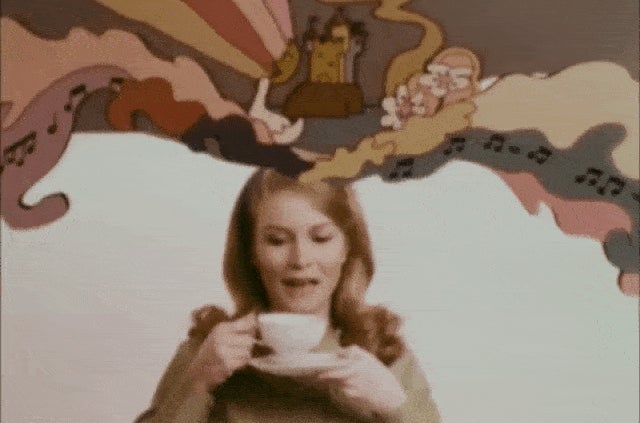Quartzy: the psychedelic edition
Happy Friday!

Happy Friday!
Last week, after learning of the writer Tom Wolfe’s death, I reopened my old copy of The Electric Kool-Aid Acid Test—Wolfe’s 1968 account of a stint with the writer Ken Kesey, the Merry Pranksters, and loads of LSD.
As I wrote for Quartzy, the book still stands up, 50 years after publication. A seminal work of “new journalism,” the Acid Test reads like a novel, peppered with complicated, messy moments of its place and time, as well as prescient details connecting today’s cyberculture to the counterculture that preceded it. (See: Stewart Brand, who would establish the Whole Earth catalog and become an early architect of the internet, tripping at age 27, just “an ex-biologist who had run across the Indian peyote cults in Arizona and New Mexico.”)

The book also contains some timeless descriptions of the shift in perception Wolfe experienced after taking LSD. At one point, after exploring the relationship between the Merry Pranksters and Jung’s theory of synchronicity, Wolfe riffed on man as “an atom in a molecule in a fingernail of a giant being,”
Sometimes, he surmised, we might catch a fleeting glimpse of a “another fingernail from another finger flashing by,” or even the giant being’s face. And sometimes, a “quirk of metabolism” or drug may open our doors of perception, and allow us to see ourselves as part of a much bigger pattern altogether.
Fifty years later, the warm reception for Michael Pollan’s new book, How to Change Your Mind, suggests Americans may be once again ready for a psychedelic renaissance, writes Quartz’s Olivia Goldhill. Pollan, of course, is the author of The Omnivore’s Dilemma, the 2006 bestseller that prompted countless people consider the consequences of their food choices. With How to Change Your Mind—and the corresponding New York Times Magazine excerpt, Rolling Stone interview, NPR Fresh Air episode, New York Magazine microdosing guide—one has to wonder whether we’re on the brink of a similar paradigm shift when it comes to societal acceptance of psychedelics. (Or at the very least, marvel at how enthused journalists are at the prospect.)

Pollan explores how chemicals including LSD and psilocybin—the compound found in magic mushrooms—could help people overcome depression or the mortal fear that comes with a fatal diagnosis, or just improve their lives. After taking psilocybin, the author describes his sense of self scattering to the wind like a pile of Post-Its (which really hits home for this writer), as he watched from outside himself, unperturbed:
“What I brought back from that experience was that I’m not identical to my ego,” Pollan told Terry Gross, on Fresh Air. “That there is another ground on which to plant our feet, and that our ego is kind of this character that is chattering neurotically in our minds. And it’s good for lots of things. I mean, the ego got the book written, but it also can be very harsh, and it’s liberating to have some distance on it. And that was a great gift, I think.”

The self is an illusion anyway! As Quartz’s Ephrat Livni wrote in February, our sense of self is the product of our brain’s Default Mode Network (DMN), which is responsible for bringing meaning to our experiences. Psychedelics can effectively “mute” the DMN, making it easier for people to perceive themselves as a piece of a bigger whole—whether a forest, a universe, or as Wolfe wrote, “a giant being.”

Ephrat points out that you don’t need magic mushrooms to achieve this: “Sometimes our consciousness shifts,” she wrote. “The boundaries of the self seem to become less rigid and we commune with another person or thing, as can happen during drug-induced epiphanies, sure—but can also happen when people fall in love, meditate, go out in nature, or experience a great meeting of minds.”
“This is water.” The writer David Foster Wallace talked about cultivating this shift in perception in his famous 2005 Kenyon College commencement speech, “This is Water,” which opens with an old fish greeting a young fish: “How’s the water?” The young fish replies: “What the hell is water?”
Wallace posed that puzzled fish as a metaphor for humans in our usual state, taking our surroundings for granted, and putting our sense of self at the center of the meaning we derive from our experiences. And this, he warned, can make the banalities of daily life truly soul-sucking.

By way of example, Wallace used a very convincing description of a hungry trip to a crowded grocery store, after a long day of work. It’s made more excruciating by the sense that the traffic, the wonky shopping cart, the slow lady at checkout, are all conspiring against you—a moment of intense but relatable self-centeredness.
“It is extremely difficult to stay alert and attentive, instead of getting hypnotized by the constant monologue inside your own head,” says Wallace. “It means being conscious and aware enough to choose what you pay attention to and to choose how you construct meaning from experience. Because if you cannot exercise this kind of choice in adult life, you will be totally hosed.”
We have to keep reminding ourselves, as Wallace said: This is water. This is water.
Have a great weekend!
[quartzy-signature]


It’s Memorial Day weekend already!? Indeed it is, and Quartz’s Annaliese Griffin has advice for those gearing up for barbecue season: a $7 gadget for burger formation, with a nifty feature for stuffed burgers to boot. Before you join those who sneer at single-use kitchen tools (I will not apologize for my garlic press), consider that the person who brought this one home was Annaliese’s husband Tom Mylan, who has been described as a “rock star butcher” and “master of careful cuts” by the US paper of record. Annaliese explains that her Cuisinart burger press limits the development of fibrous strands in the meat called myosin, which wreak havoc on overworked burgers, causing them to contract as they cook, wringing out delicious fats and juices.
“It’s everything you don’t want,” Tom told his wife, I like to imagine in a dramatic whisper. This burger-maker, on the other hand, I do.